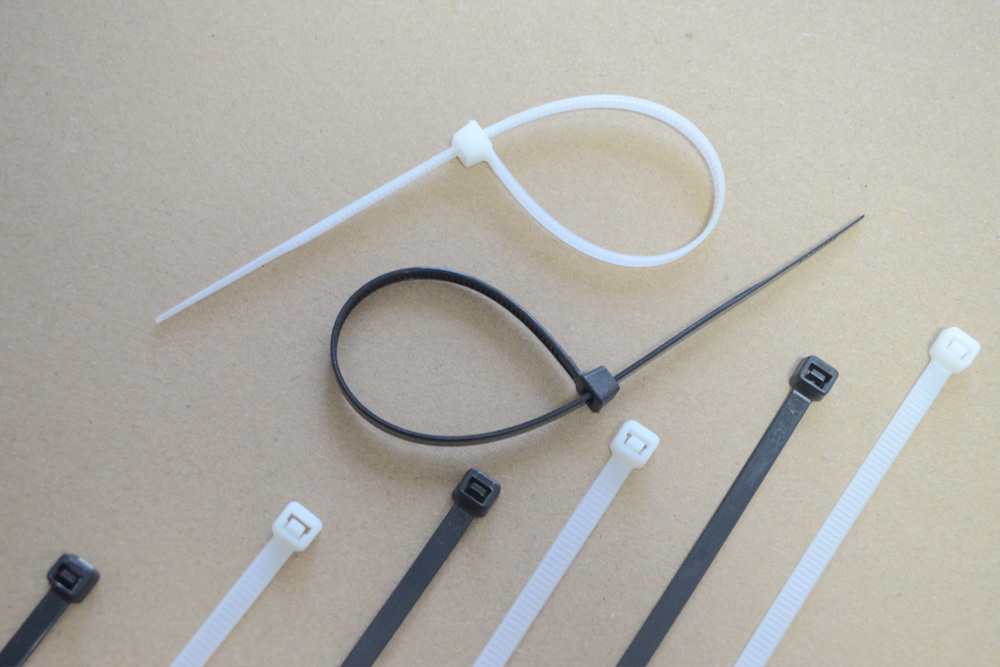18
2025
-
11
Insulation performance of PPS plastic cable ties
Author:
Electrical Insulation Fundamentals of PPS Cable Ties
Polyphenylene sulfide (PPS) cable ties derive their insulation capabilities from a molecular structure composed of alternating benzene rings and sulfur atoms. This arrangement creates a highly crystalline polymer with non-polar characteristics, resulting in exceptional electrical resistance. The material maintains a volume resistivity exceeding 10¹⁵ Ω·cm and a surface resistivity above 10¹⁴ Ω/sq, ensuring minimal current leakage even in high-voltage environments.
Unlike conventional nylon or polyethylene ties, PPS exhibits negligible dielectric absorption, preventing energy storage that could lead to electrical failures. Its dielectric constant remains stable at approximately 3.0 across a wide frequency range (50Hz–10GHz), making it suitable for both low-frequency power systems and high-frequency electronic applications. This stability arises from the material’s low polarization under alternating electric fields, a critical factor for components operating in variable electromagnetic conditions.
Performance Under Extreme Environmental Conditions
PPS cable ties demonstrate superior insulation retention in harsh settings. When exposed to temperatures up to 260°C (continuous use), the material’s electrical properties remain unaffected, whereas standard plastics like PA66 begin degrading above 150°C. This thermal resilience stems from PPS’s high glass transition temperature (Tg ≈ 90°C) and melting point (285°C), which prevent structural breakdown under heat stress.
In humid environments, PPS’s low water absorption rate (≤0.1%) ensures consistent insulation performance. Unlike materials such as PET or PBT, which absorb moisture and develop conductive pathways, PPS maintains its resistivity even after prolonged exposure to 85% relative humidity at 85°C. This property is particularly valuable for outdoor electrical installations in tropical or coastal regions.
The material’s chemical inertness further enhances its reliability. PPS resists degradation from oils, solvents, and acids commonly found in industrial settings. For instance, tests show no significant change in dielectric strength after immersion in 10% sulfuric acid or diesel fuel for 1,000 hours at room temperature. This resistance minimizes the risk of insulation failure in chemical processing plants or automotive engine compartments.
Applications in High-Voltage and High-Frequency Systems
PPS cable ties excel in applications demanding stringent electrical safety standards. In power distribution networks, they secure cables in transformers and switchgear operating at voltages up to 36kV, where their arc resistance (CTI ≥ 600V) prevents tracking and erosion caused by electrical discharges. The material’s flame-retardant nature (UL94 V-0 rating without additives) adds an extra layer of protection against fire hazards.
For electronic devices, PPS’s low dielectric loss (tanδ ≤ 0.001 at 1MHz) reduces signal attenuation in high-speed data transmission lines. This makes it ideal for bundling cables in 5G infrastructure, automotive Ethernet systems, and aerospace avionics, where maintaining signal integrity is critical. The material’s dimensional stability under thermal cycling (±0.1% shrinkage after 1,000 cycles from -40°C to 150°C) ensures long-term reliability in dynamic environments.
Material Enhancements for Specialized Insulation Needs
Manufacturers modify PPS formulations to address specific electrical requirements. Glass fiber-reinforced grades (20–40% GF) increase tracking resistance (CTI ≥ 1000V) for use for high-voltage connectors, while mineral-filled variants improve thermal conductivity for power electronics cooling systems. Nanocomposite PPS incorporating boron nitride or alumina particles achieves a thermal conductivity of 5–10 W/m·K, enabling efficient heat dissipation in IGBT modules and LED drivers.
Surface treatments like plasma etching enhance PPS’s adhesion to conductive coatings, facilitating its use in electromagnetic interference (EMI) shielding applications. These modified ties can secure shielded cables while maintaining electrical continuity between grounding points. Additionally, halogen-free formulations comply with RoHS and REACH regulations, making them suitable for consumer electronics and medical devices.
Long-Term Reliability and Industry Adoption
Field data from automotive manufacturers demonstrate PPS cable ties’ durability in engine compartments, where they endure 15 years of continuous operation at 125°C without insulation degradation. Similarly, offshore wind turbine operators report zero failures in PPS-secured cables after five years of exposure to salt spray and UV radiation. These real-world performances validate the material’s suitability for critical infrastructure projects.
The aerospace sector leverages PPS’s radiation resistance (up to 10⁶ Gy) for satellite wiring harnesses, where traditional insulation materials would degrade under cosmic rays. In medical imaging equipment, PPS ties’ low outgassing properties prevent contamination in MRI machines, ensuring accurate diagnostic results. As industries demand materials capable of withstanding harsher operating conditions, PPS’s unique combination of electrical, thermal, and chemical stability positions it as a preferred solution for advanced insulation challenges.
plastic cable ties
Hot News
2025-11-18
Insulation performance of PPS plastic cable ties
Polyphenylene sulfide (PPS) cable ties derive their insulation capabilities from a molecular structure composed of alternating benzene rings and sulfur atoms. This arrangement creates a highly crystalline polymer with non-polar characteristics, resulting in exceptional electrical resistance. The material maintains a volume resistivity exceeding 10¹⁵ Ω·cm and a surface resistivity above 10¹⁴ Ω/sq, ensuring minimal current leakage even in high-voltage environments.
2025-11-18
The oil resistance property of PA46 plastic cable ties
PA46 (Polyamide 46), a high-performance polyamide resin synthesized from butylenediamine and adipic acid, exhibits exceptional resistance to oils and solvents due to its molecular structure. The material’s 70% crystallinity and symmetrical chain arrangement create a dense, ordered polymer matrix that limits diffusion of chemical agents. Unlike conventional polyamides such as PA6 or PA66, PA46’s shorter molecular chains and higher amide group density reduce free volume, minimizing space for oil molecules to penetrate.
2025-11-17
Low-temperature toughness of TPU plastic cable ties
Thermoplastic polyurethane (TPU) plastic cable ties derive their low-temperature resilience from a carefully engineered molecular architecture. The material consists of alternating soft segments (polyether or polyester polyols) and hard segments (diisocyanate-chain extender reaction products).
2025-11-17
Tensile strength of stainless steel core plastic cable ties
Stainless steel core plastic cable ties combine the durability of metal with the protective properties of polymer coatings. The stainless steel core, typically made of 304 or 316 grade alloys, provides the primary load-bearing capacity.

